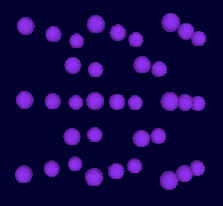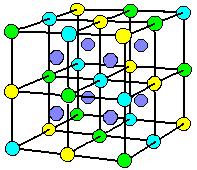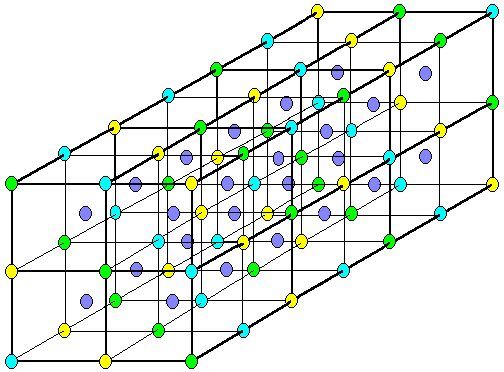
RUBIDIUM (37),
LANTHANUM (57)
&
THE
LOGICALLY OUTFITTED
CUBE(S)
The crystal structure of Rubidium, atomic number 37,1 is body-centered cubic, as here illustrated:2

This structure formally coincides that of the
logically
outfitted dead center cube with the addition of places for 8 atoms, each at the center
of one of 8 cubic subdivisions, as here illustrated:

Let the formal structure of the logically outfitted triple dead center cube be superimposed on a triple-Rubidium-3-cube, as here illustrated:

Then Rubidium, atomic number 37, formally coincides the trinary logical
structure whose cubic diagonals are 37 in number.
The body-diagonal of this crystal structure = 3704.66989082698 pm (the number of
units ![]() 3700 + the Feigenbaum
constant, d). The triple-Rubidium-3-cube
has in addition to the 63 occupied cube vertices of the logically outfitted triple dead
center cube 24 occupied cubic centers. The ratio of the 63 atoms occupying the
vertices of this triple-cube to the 24 atoms occupying its cubic centers is approximately
the square of the ratio of the atomic weight of Lanthanum, atomic number 57, to that of
Rubidium, atomic number 37, (Law/Rbw)2,
or, where j is the golden section ratio, approximately φ2.3
3700 + the Feigenbaum
constant, d). The triple-Rubidium-3-cube
has in addition to the 63 occupied cube vertices of the logically outfitted triple dead
center cube 24 occupied cubic centers. The ratio of the 63 atoms occupying the
vertices of this triple-cube to the 24 atoms occupying its cubic centers is approximately
the square of the ratio of the atomic weight of Lanthanum, atomic number 57, to that of
Rubidium, atomic number 37, (Law/Rbw)2,
or, where j is the golden section ratio, approximately φ2.3
Further, when the logically outfitted triple dead center cube is formally superimposed on the triple-Rubidium-3-cube as indicated, the places occupied by the 24 cubic centers assimilated to the logical structure are centers for 24 3-place diagonals, as here illustrated:
These diagonals are formally shorter than the 3-place diagonals of the logically outfitted triple dead center cube. Also, unlike the latter, the 3-place diagonals in this set are of identical length. The total number of diagonals in the two sets (noting that the 6 diagonals supported by logically blue atomic positions follow the path of 3 of the blue diagonals in the original logical arrangement) is 61 (the original 37 + these 24). Neatly, the 24 diagonals in the triple-Rubidium-3-cube occupy 61 atomic places, as illustrated, exactly 37 of which belong to the original structure of the logically outfitted triple dead center cube. As in the purely logical analysis the 37 diagonals naturally sort themselves into a set of 20 exterior-interior surface and 17 interior (non-surface) diagonals, so, analogously, the 37 atomic places here coinciding the logical positions sort themselves into 20 occupying the outer lengthwise sides of the triple-Rubidium-3-cube crystal structure and 17 occupying the inner lengthwise plane. Also, 48 of the 61 atoms supporting the 24 additional diagonals occupy logically yellow or green places while 13 occupy logically blue places. Just as the blue diagonals in the triple dead center cube form a unit uniting the poles of the triple cube, so the atoms occupying logically blue places in the Rubidium crystal structure do likewise.4 The ratio 48/13 = (37/10)-(13×10)−1.
If the total number of logical diagonals in the triple-Rubidium-3-cube crystal structure is 61 = 37+24, then, where 82944 is the common coefficient of the four fundamental force constants,5 and 216 pm is the value of the covalent radius of the Rubidium atom, and 169 pm is the value of the covalent radius of the Lanthanum atom, and 37 is the original number of diagonals in the logically outfitted dead center cube, and 24 is the number of additional diagonals in the logically outfitted Rubidium crystal structure, the deep structure of the ratio of the covalent atomic radius of Rubidium (37) to that of Lanthanum (57) is the following:
1082944/(37×242)/102(37+24) = 216/169.6
Notes
1 The resonance frequency
of the rubidium atom (87Rb) = 6834682608 Hz ~ 829442 Hz. GPS
satellites carry both cesium and rubidium clocks. The writer is indebted to Mr. J.
Iuliano for calling attention to the numerical relation of the elements Rubidium and
Lanthanum. On July 11, 2000, he communicated to the writer his observation
concerning the numbers 37 and 57 as they appear in the periodic table. He discovered
(the latest values for the physical constants have been substituted by the writer) that,
where Rbn = 37 (the atomic number of Rubidium), and Lan
= 57 (the atomic number of Lanthanum), and Rbw = 85.4678 (the atomic
weight of Rubidium), and Law = 138.9055 (the atomic weight of
Lanthanum), and 2807/1579 is the ratio of certain eigenvalues in Mr. Iuliano's research on
Fermat's last theorem, e(16/π)(Rbw/Law)(2807/1579) × (1/Rbn+1/Lan) ![]() α−1/2,
the inverse square root of the fine structure constant. For the equivalent
formulas, e2π−1(e2807.000184[2/1579])
× (1/57+1/37) = 11.7062372 . . . , and e2π−1(e[2808-(1-[(37-37−1)10πδ]−1)][784+5.5]−1) ×
(1/57+1/37) = 11.7062372007985 . . . , see, on this web,
82944 & the Four Fundamental Forces & the God Particle.
Mr. Iuliano also noted (with similar substitutions by the writer) that, where the critical exponent β = .37, and the Feigenbaum bifurcation
constant δ = 4.669201609102990.
. ., and the gravitational constant G = 6.67390 × 10−11, (β × 10-5)/(δRbwLaw)
α−1/2,
the inverse square root of the fine structure constant. For the equivalent
formulas, e2π−1(e2807.000184[2/1579])
× (1/57+1/37) = 11.7062372 . . . , and e2π−1(e[2808-(1-[(37-37−1)10πδ]−1)][784+5.5]−1) ×
(1/57+1/37) = 11.7062372007985 . . . , see, on this web,
82944 & the Four Fundamental Forces & the God Particle.
Mr. Iuliano also noted (with similar substitutions by the writer) that, where the critical exponent β = .37, and the Feigenbaum bifurcation
constant δ = 4.669201609102990.
. ., and the gravitational constant G = 6.67390 × 10−11, (β × 10-5)/(δRbwLaw)
![]() G. For the critical exponent
β
= .37, see, below, note 3.
G. For the critical exponent
β
= .37, see, below, note 3.
2 Illustration from an
interactive viewing at M. Winter, "WebElementsTM
Periodic Table." WebElements Ltd, UK. Online. Available:
http://www.webelements.com. July 14, 2000.
3 While other elements have
Rubidium's cubic body-centered form, only in the case of Rubidium (37) and Lanthanum (57)
does the weight ratio correspond to the structural ratio as indicated. These
elements also have the neat weight/number interrelational property such that (Rbw+Law)(1/Rbn+1/Lan)
![]() 10.
Similarly, on the analogy to the composition of the value (above, in the
text) of the triple cubic crystal body-diagonal, 57.37(Rbw+Law)
= 1000 + δ/π.
The inverse of δ/π appears in the fine structure formula, [7800-(π/δ)4]1/2/.6444762592780 =
α−1 =
137.035999594927. For the formulas equivalent to this last, see, on this web,
82944 & the Four Fundamental Forces & the God
Particle, note 14, and also, on this web,
Report on a Dream & Related Matters & the God Particle,
passim. Also, as pointed out by Mr. Iuliano, where α = 2.502907875095892, the Feigenbaum distance constant, (Lan/Rbn)(Law/Rbw)
10.
Similarly, on the analogy to the composition of the value (above, in the
text) of the triple cubic crystal body-diagonal, 57.37(Rbw+Law)
= 1000 + δ/π.
The inverse of δ/π appears in the fine structure formula, [7800-(π/δ)4]1/2/.6444762592780 =
α−1 =
137.035999594927. For the formulas equivalent to this last, see, on this web,
82944 & the Four Fundamental Forces & the God
Particle, note 14, and also, on this web,
Report on a Dream & Related Matters & the God Particle,
passim. Also, as pointed out by Mr. Iuliano, where α = 2.502907875095892, the Feigenbaum distance constant, (Lan/Rbn)(Law/Rbw)
![]() α.
For the fundamentality of the occurrence of 37, both alone & in its ubiquitous
conjunction with 57, see, on this web,
82944 & the
Four Fundamental Forces & the God Particle, including additional
references passim. Further to the point, on July 16, 2000, Mr. Iuliano called the
writer's attention to the fact that (Law - Rbw)16/15
= 57. The writer noticed the relationship between 16/15, the critical exponent .37,
the fine structure constant, α, and the edge of the
dead center cube, 10368.5, as follows: [([16/15].37)2 ×
1E33]−1/256/10368.5 = α. For the equivalent of this formula in terms of the
product of the ratios of the nuclear and universal force exponents of 82944, cf. ibid.,
note 9. In this last connection, note
here also that, where
α is the fine structure
constant, and β is the
critical exponent .37, and
φ is the golden section ratio,
829441/p + φ(.82944-[2807/1579]−16) =
(α−1)2b. (For .82944, cf., below, note 4.) Likewise,
829441/π + φ(.82944-[(RbnLan)/(Rbn+Lan)]-8β) = 829441/π +
φ(.82944-[(Rbw+Law)/10]-8β) = (α−1)2β. Where 3704.66989082698 is the value (above, in the text) of the triple cubic
crystal body-diagonal of Rubidium, 829441/π +
φ(.82944-[82944/3704.66989082698]-8β) = (α−1)2β. Coincidentally, on July 27, 2000, Mr. Iuliano
called the writer's attention to the values of the six quarks as presented in B. Greene, The
Elegant Universe: Superstrings, Hidden Dimensions, and the Quest for the Ultimate Theory
(New York, 1999). The writer noted that, where (following Greene) u is the
atomic mass unit value of the up quark, .0047, and d is the value of the down quark,
.0074, and c is the value of the charm quark, 1.6, and s is the value of the strange
quark, .16, and t is the value of the top quark, 189, and b is the value of the bottom
quark, 5.2, it is also the case that 829441/π +
φ(.82944-[([udcstb/(u+d+c+s+t+b)]103)−1]-8β) = (α−1)2β. For the
length of the edge of the dead center cube, cf. D.G.
Leahy, Foundation: Matter the Body Itself (Albany, 1996), p. 434, et
passim. For the fundamental role of the ratio 22.4
α.
For the fundamentality of the occurrence of 37, both alone & in its ubiquitous
conjunction with 57, see, on this web,
82944 & the
Four Fundamental Forces & the God Particle, including additional
references passim. Further to the point, on July 16, 2000, Mr. Iuliano called the
writer's attention to the fact that (Law - Rbw)16/15
= 57. The writer noticed the relationship between 16/15, the critical exponent .37,
the fine structure constant, α, and the edge of the
dead center cube, 10368.5, as follows: [([16/15].37)2 ×
1E33]−1/256/10368.5 = α. For the equivalent of this formula in terms of the
product of the ratios of the nuclear and universal force exponents of 82944, cf. ibid.,
note 9. In this last connection, note
here also that, where
α is the fine structure
constant, and β is the
critical exponent .37, and
φ is the golden section ratio,
829441/p + φ(.82944-[2807/1579]−16) =
(α−1)2b. (For .82944, cf., below, note 4.) Likewise,
829441/π + φ(.82944-[(RbnLan)/(Rbn+Lan)]-8β) = 829441/π +
φ(.82944-[(Rbw+Law)/10]-8β) = (α−1)2β. Where 3704.66989082698 is the value (above, in the text) of the triple cubic
crystal body-diagonal of Rubidium, 829441/π +
φ(.82944-[82944/3704.66989082698]-8β) = (α−1)2β. Coincidentally, on July 27, 2000, Mr. Iuliano
called the writer's attention to the values of the six quarks as presented in B. Greene, The
Elegant Universe: Superstrings, Hidden Dimensions, and the Quest for the Ultimate Theory
(New York, 1999). The writer noted that, where (following Greene) u is the
atomic mass unit value of the up quark, .0047, and d is the value of the down quark,
.0074, and c is the value of the charm quark, 1.6, and s is the value of the strange
quark, .16, and t is the value of the top quark, 189, and b is the value of the bottom
quark, 5.2, it is also the case that 829441/π +
φ(.82944-[([udcstb/(u+d+c+s+t+b)]103)−1]-8β) = (α−1)2β. For the
length of the edge of the dead center cube, cf. D.G.
Leahy, Foundation: Matter the Body Itself (Albany, 1996), p. 434, et
passim. For the fundamental role of the ratio 22.4
![]() (RbnLan)/(Rbn+Lan)
(RbnLan)/(Rbn+Lan) ![]() (Rbw+Law)/10
(Rbw+Law)/10 ![]() 82944/3704.66989082698
82944/3704.66989082698 ![]() [(udcstb/[u+d+c+s+t+b])103]−1, uncovered in the logico-mathematical analysis of Foundation,
as well as for that of 16/15 (=
[(udcstb/[u+d+c+s+t+b])103]−1, uncovered in the logico-mathematical analysis of Foundation,
as well as for that of 16/15 (=
![]() ), and of
its square (=
), and of
its square (= ![]() ), see, ibid.,
Index of Numbers and Symbols, pp. 687ff. Note that the body-diagonal of the
triple-Rubidium-3-cube crystal structure, 3704.66989082698 pm, ~ one10-billionth of the
Egyptian remen (cf., on this web,
Sorted Diagonals, Addendum 5).
), see, ibid.,
Index of Numbers and Symbols, pp. 687ff. Note that the body-diagonal of the
triple-Rubidium-3-cube crystal structure, 3704.66989082698 pm, ~ one10-billionth of the
Egyptian remen (cf., on this web,
Sorted Diagonals, Addendum 5).
4 Cf., on this web,
Sorted Diagonals. Where (y+g)/b is the ratio of the
total length of the yellow & green diagonals to the total length of the blue diagonals
in the logically outfitted triple dead center cube, and (Y+G)/B is the analogous ratio in the
triple-Rubidium-3-cube, and ae
is the electron magnetic moment anomaly, then [b(Y+G)/B(y+g)]-.1(37/20) × (1 + αe)
![]() .82944
× (1 + αe).25.
(For .82944, cf., above, note 3.) For more on the lengths of the diagonal sets in
the logically outfitted triple dead center cube, see, on this web,
Sorted Diagonals, Addendum 10.
.82944
× (1 + αe).25.
(For .82944, cf., above, note 3.) For more on the lengths of the diagonal sets in
the logically outfitted triple dead center cube, see, on this web,
Sorted Diagonals, Addendum 10.
5 Cf., on this web,
82944 & the Four Fundamental Forces & the God Particle
and The vmaxwell1/16
× 1 s/m Cube, Human Body Surface & BSA, &
the Infinitely Flat Structure of the Universe.
6 This
formula is a transcription into logically significant terms, as demonstrated, of a formula
discovered by Mr. Iuliano and forwarded to the writer on August 29, 2000. Mr.
Iuliano's formula relating the covalent radii of Rubidium and Lanthanum in nanometers is
as follows:
1082943.99305/(666×32)/102(37+24) = .215997356/.169.
This formula should be compared to that first
forwarded by Mr. Iuliano on February 23, 1999 (cf. on this web,
82944 & the Four Fundamental Forces & the God Particle). Mr. Iuliano also reminds the writer that the covalent
atomic radius of Hydrogen (1) is 37 pm. Note also that 1082944/(37×242)/102(37+24)
![]() 8.25/3.25,
the square root of the ratio of the relative length of the shortest diagonals in the
logically outfitted triple cube to that of the diagonals in the triple-Rubidium-3-cube.
The latter ratio is at once the ratio of the diagonal of the base to the height of the smallest square-based pyramid the area of whose face is a whole number not 1
and one half the area of the base of the pyramid, and the sum of whose ascending edge and
one half the base of its face is to the height of its face as φ : 1 (cf., on this web,
Thinking Creation Ex Nihilo; cf., also, Leahy, Foundation, Section IV.2).
8.25/3.25,
the square root of the ratio of the relative length of the shortest diagonals in the
logically outfitted triple cube to that of the diagonals in the triple-Rubidium-3-cube.
The latter ratio is at once the ratio of the diagonal of the base to the height of the smallest square-based pyramid the area of whose face is a whole number not 1
and one half the area of the base of the pyramid, and the sum of whose ascending edge and
one half the base of its face is to the height of its face as φ : 1 (cf., on this web,
Thinking Creation Ex Nihilo; cf., also, Leahy, Foundation, Section IV.2).